► Ferrari’s Daytona SP3 driven on the road
► Design inspired by legendary racing Ferraris
► 599 to be built, all sold at price of €2m
Ordinarily, this would be the dullest of driving environments. A nondescript stretch of dual carriageway, in steady drizzle, in a forgettable bit of Germany. But in the Ferrari SP3 Daytona, it feels like a stint at Le Mans in the late ’60s or early ’70s. The trees the other side of the grey armco are rushing past in Cinemascope, and beads of rain elongate and slide across the deeply bowled screen like speed-line graphics in a sci-fi jump to hyperspace.
They’re interrupted by a central single wiper blade, just like a classic sports prototype. Two curving humps over the front wheelarches frame the view ahead through the wraparound screen, topped by staggered mirrors. They reflect a roostertail of spray, trailing the sound of a big-capacity, naturally aspirated V12.
That’s the entire point of this car: to fire imagination, to be a wheeled storyteller. It feels just how I’d imagine it would to be at the wheel of a Ferrari 330 P4, a 512 S or another of Ferrari’s golden-era sports racers this car takes its inspiration from. The SP3 Daytona is so named because it’s the third model in Ferrari’s Icona series, Maranello’s series of low-volume, money-almost-no-object machines inspired by different eras of its history, sold to clients and collectors on first-name terms with the factory, and considered to be ambassadors for the brand.
We ride in Ferrari’s Monza SP1 and SP2
Why is it called the Daytona?
The Daytona SP3’s name comes from the 1967 Daytona 24 Hours, where Ferrari (still stung by Ford’s clean sweep at Le Mans ’66) took the top three places with the achingly beautiful 330 P3/4, 330 P4 and 412P. The SP3 follows the Monza SP1 and SP2 in the Icona series (SP standing for Special Project).
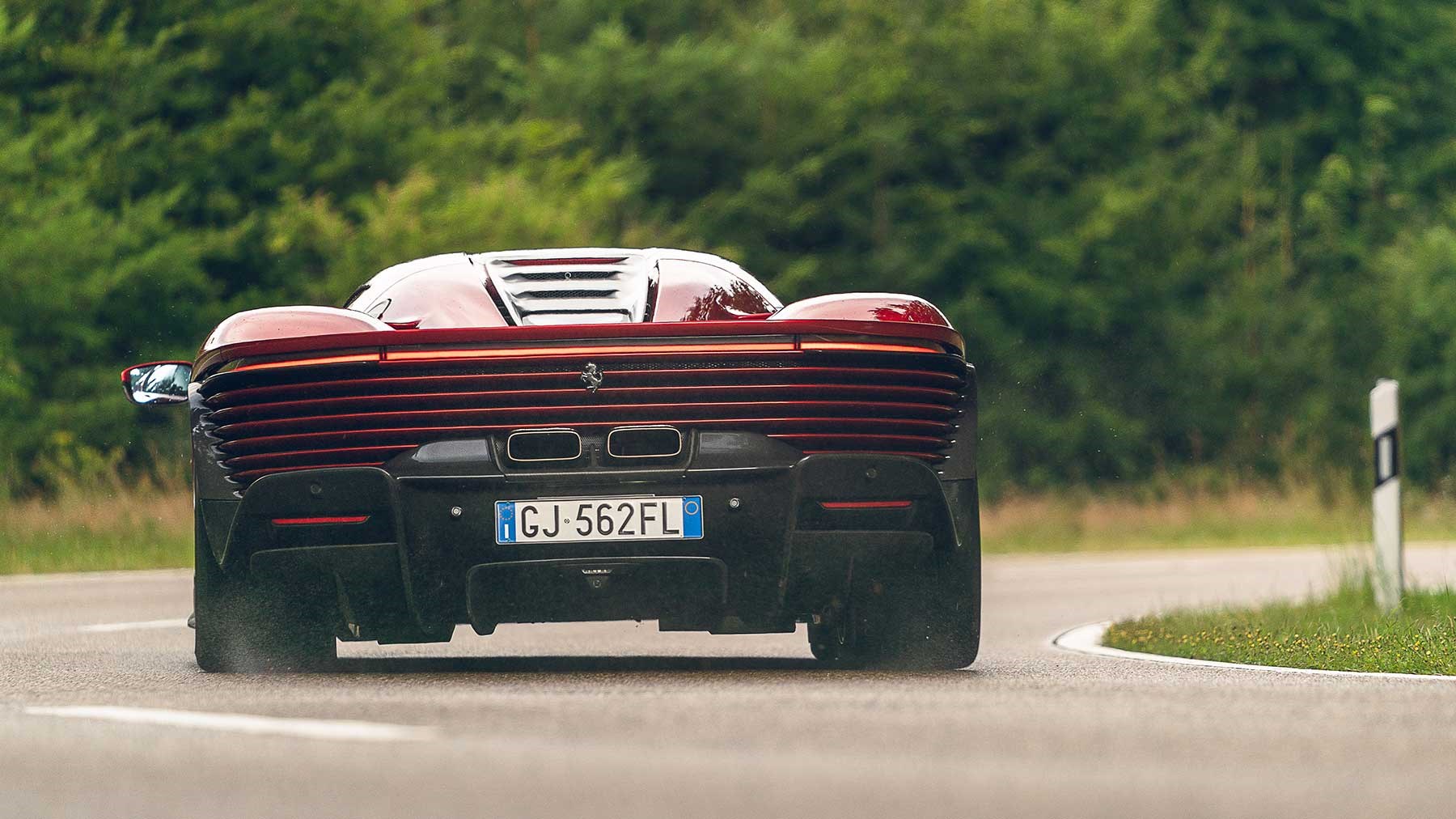
A run of 599 SP3s will be built, sold at a price of €2 million (around £1.7m at the time of writing). All were sold before the car was revealed to the public in 2021. Ferrari doesn’t disclose information about customers but does say that more than 90 per cent of Monza SP1 and SP2 owners have also decided to buy a Daytona. It’s that kind of car.
Gavin Green on the glut of hypercars on the marketplace
Ferrari Daytona SP3: Maranello’s most powerful road car ever…
It’s powered solely by a naturally aspirated V12, and is surely among the last Ferraris to be so. Although the carbonfibre chassis is an (extensive) evolution of that used in the hybrid LaFerrari Aperta, the Daytona is not hybridised.
The V12 is an evolution of the 812 Competizione’s, with various measures for reduced friction and greater use of titanium components, including the con-rods.
Without a turbocharger or an e-motor in sight, it has a power output of 829bhp, making it the most powerful road-going engine yet made by Ferrari. And it revs to 9500rpm…
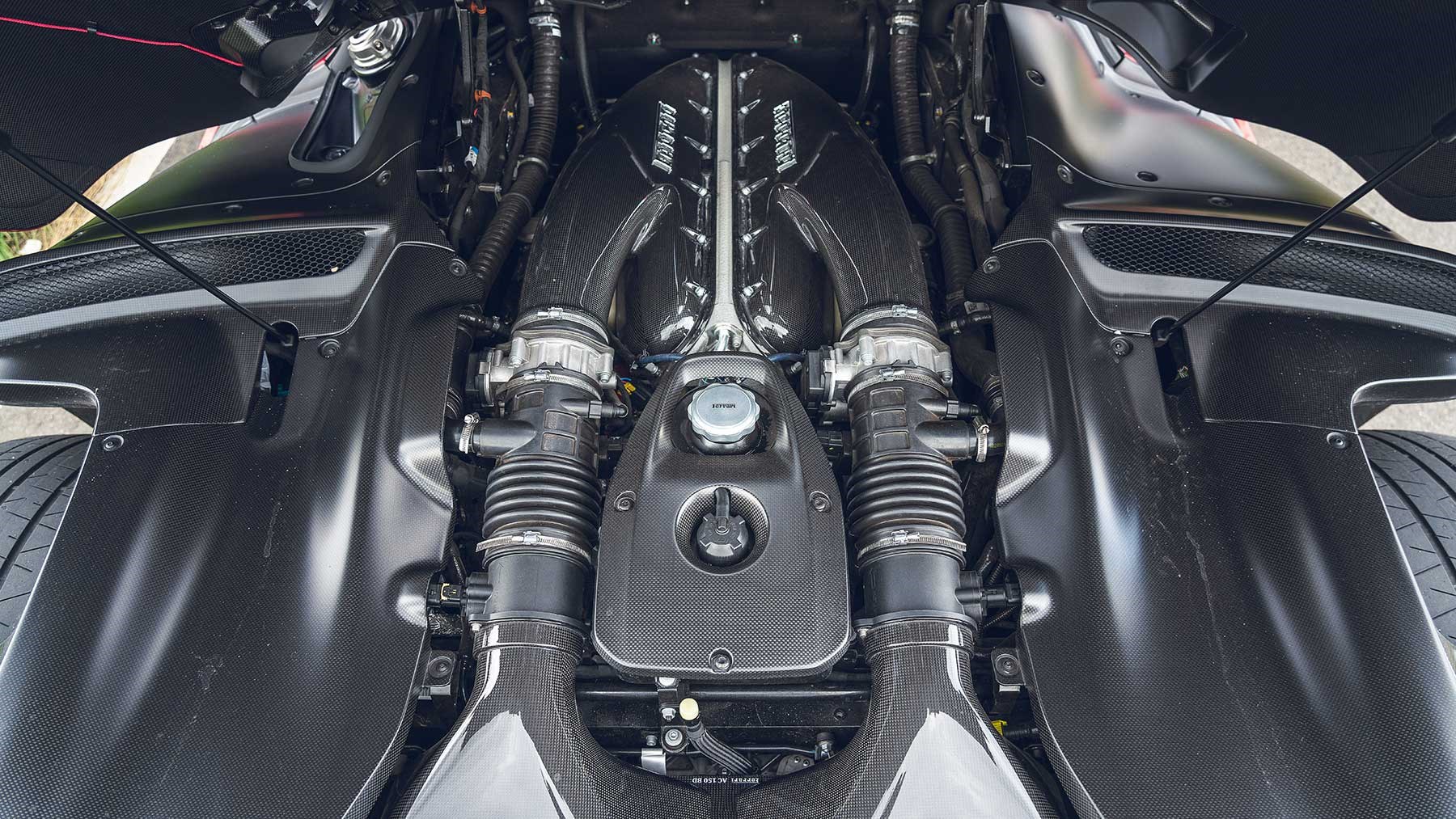
The majority of Ferraris use aluminium chassis, and this is the first carbon-tubbed, mid-engined V12 Ferrari since the LaFerrari. It’s not a simple repurposing of that car’s tub: with new windscreen and rollover structures, and no hybrid components to package on the SP3, only ‘two or three’ small components are interchangeable between the two cars’ structures.
Design: inspired by Ferrari’s greatest hits without being retro
We meet the SP3 the evening before the drive, basking in the setting sun’s soft light. It’s a captivating thing to behold. Although it’s a homage to racing Ferraris of yesteryear, it’s intended to be very much a car of today with futuristic leanings. ‘Conscious of history but futuristic in approach,’ is how design lead Stefano de Simone puts it as he shows us around the car. It really comes to life as you walk around its carbonfibre in three dimensions.
‘We spent a lot of time on the relationship between the top of the wheelarches and the top of the roof – when you first see a car the first thing your eye reads is the profile, even if the first thing you notice is a detail. And if the profile is not right…
‘If you look at the side view, it’s very “cab-forward,” like a jet,’ he adds. ‘And it’s a car you sit in, not on.’ Reach under the three-dimensional door – which incorporates layered aero channels, ducting air from the front of the car through the door’s lower half, and through an upper airbox for the central radiators – for the recessed handle, and lift it upwards. It takes away the sill and much of the front wheelarch with it to reveal two seats. Of a sort.
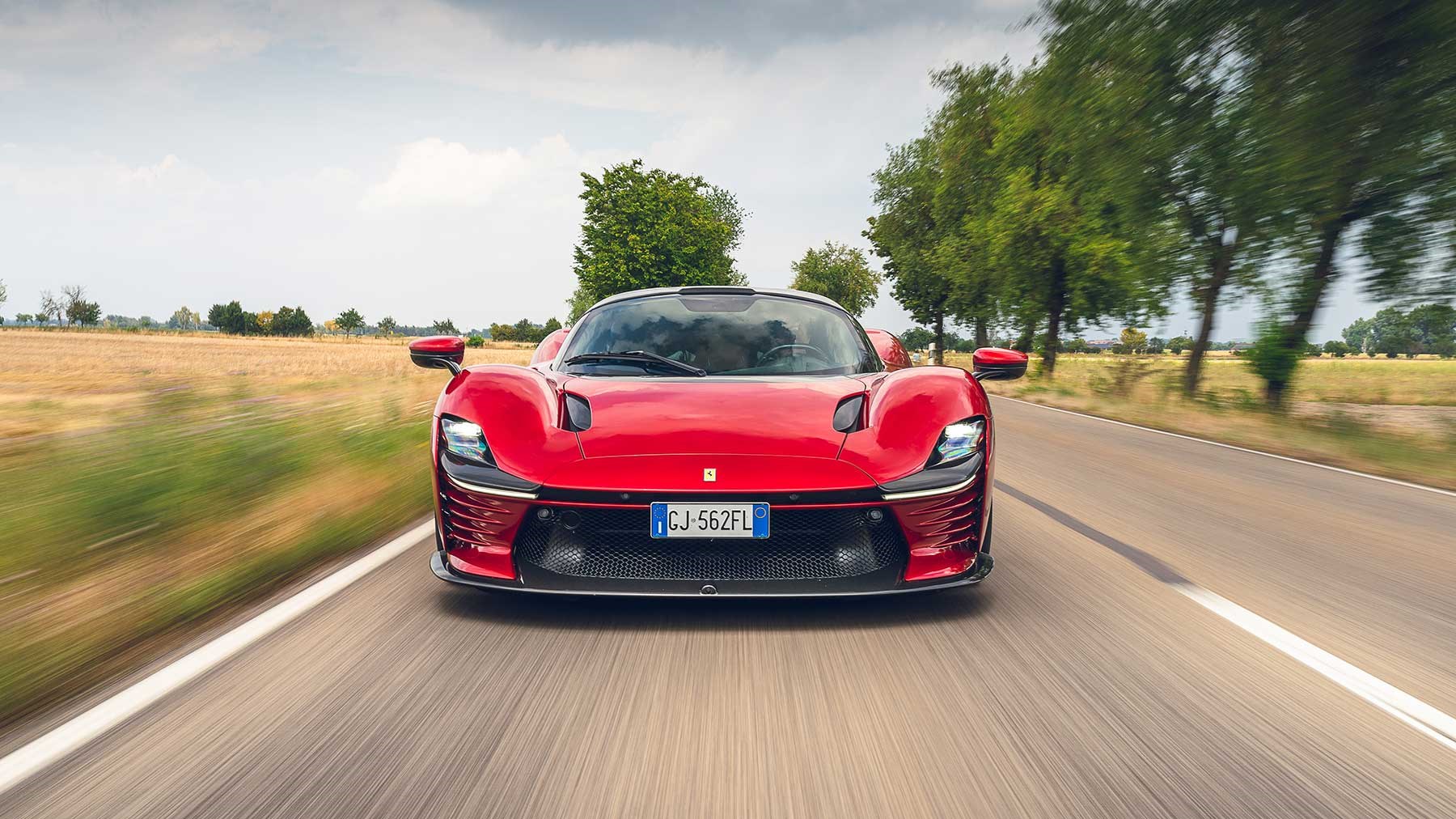
They’re actually cushioned sections affixed directly to the moulding of the chassis itself. Their artfully styled shapes colour outside the lines of a conventional cabin and extend to the doors, giving the cockpit a wraparound feel. They’re in blue alcantara in this car, although customers can choose practically any colour or material.
Both the design and engineering departments had the same brief for the SP3: make it a car about feeling, rather than numbers (even if it does still possess some pretty serious headline statistics).
‘The pencil was shaking,’ says design lead Stefano de Simone on the responsibility he felt making the first sketches, to do justice to the era the SP3 seeks to evoke. ‘I sketched also the 512 S and P4, just to capture how the designers of the time were drawing, what they were feeling. Then you stop, and think “how can we make you feel that same feeling today?”
Engineer Gabriele Pritoni says the engineering team had a similar brief: all about feeling. ‘I can say it was the same concept – the development was focused more in the feeling of the car than the absolute limit of performance. It’s the first time we had this brief.’
How comfortable are the fixed seats in the Ferrari Daytona SP3?
Surprisingly so. Since they don’t move you instead adjust the pedals, by pulling a release cord at the seat base to release the spring-loaded pedalbox. Use your left foot against the footrest to bring them forward or push them away, then release the cord and they’re locked in position. It’s simple to adjust and the driving position is fantastic – a racecar-style laydown position with your ankles almost in line with your hips. That’s far comfier than it sounds, and the steering wheel adjusts in the normal way with plenty of range for different-sized drivers. The wheel’s smaller than that of most modern Ferraris, and it feels perfect to hold.
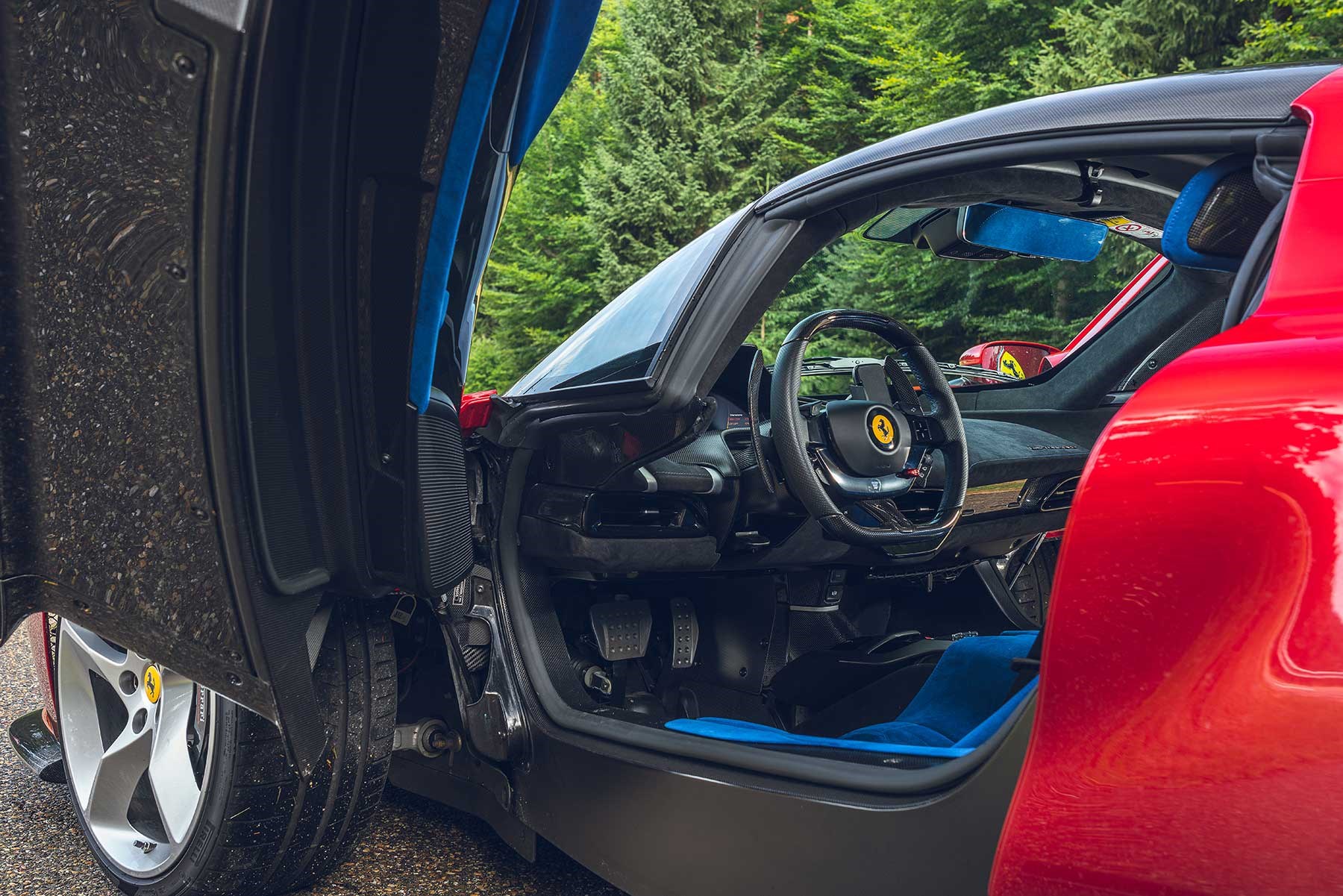
Like other Ferraris, it’s festooned with switchgear: indicators, wipers, cruise control, infotainment controls and much more besides. Behind it is the latest-generation digital display screen, as seen on Roma, SF90 and the 296 GTB. Like those cars, it’s a busy design and I find it fiddly to operate via touchpads on the steering wheel and on the dashboard.
And how does it feel to drive?
We began our journey near Hockenheimring, where the forests once echoed to Ferrari V12s when this car’s inspiration sources were racing, and where the SP3 will be on show at a Ferrari Challenge race festival tomorrow. We’re striking south to the Black Forest, in search of roads and scenery that might put the Daytona in its happiest habitat.
The drizzle has cleared, the derestricted autobahn is drying swiftly and there’s a gap in traffic. Let’s see how 829bhp feels.
At low revs the V12 isn’t particularly sonorous, more a hubbub of mechanical noise (but a relatively quiet one, to its credit on the motorway). Plant your right foot and that changes. A deep, rich sound gains higher-pitched tones as the revs rise and shift lights begin to illuminate on the steering wheel. Zero to 124mph is quoted as 7.4sec, and that feels believable. Autobahn traffic calls time before 170mph but the SP3 feels like it could keep going forever.
Which is exactly how its engine response has been engineered: the torque curve has been tuned carefully so it has a never-ending feel, with relatively little pull at the bottom of the rev range but maximum 514lb ft arriving at 7250rpm, handing the baton on to the power curve which peaks at 9250rpm. So there’s absolute incentive to keep going and going all the way to that 9500rpm ceiling, with 12 big-capacity cylinders soaring away behind you. It’s heady stuff.
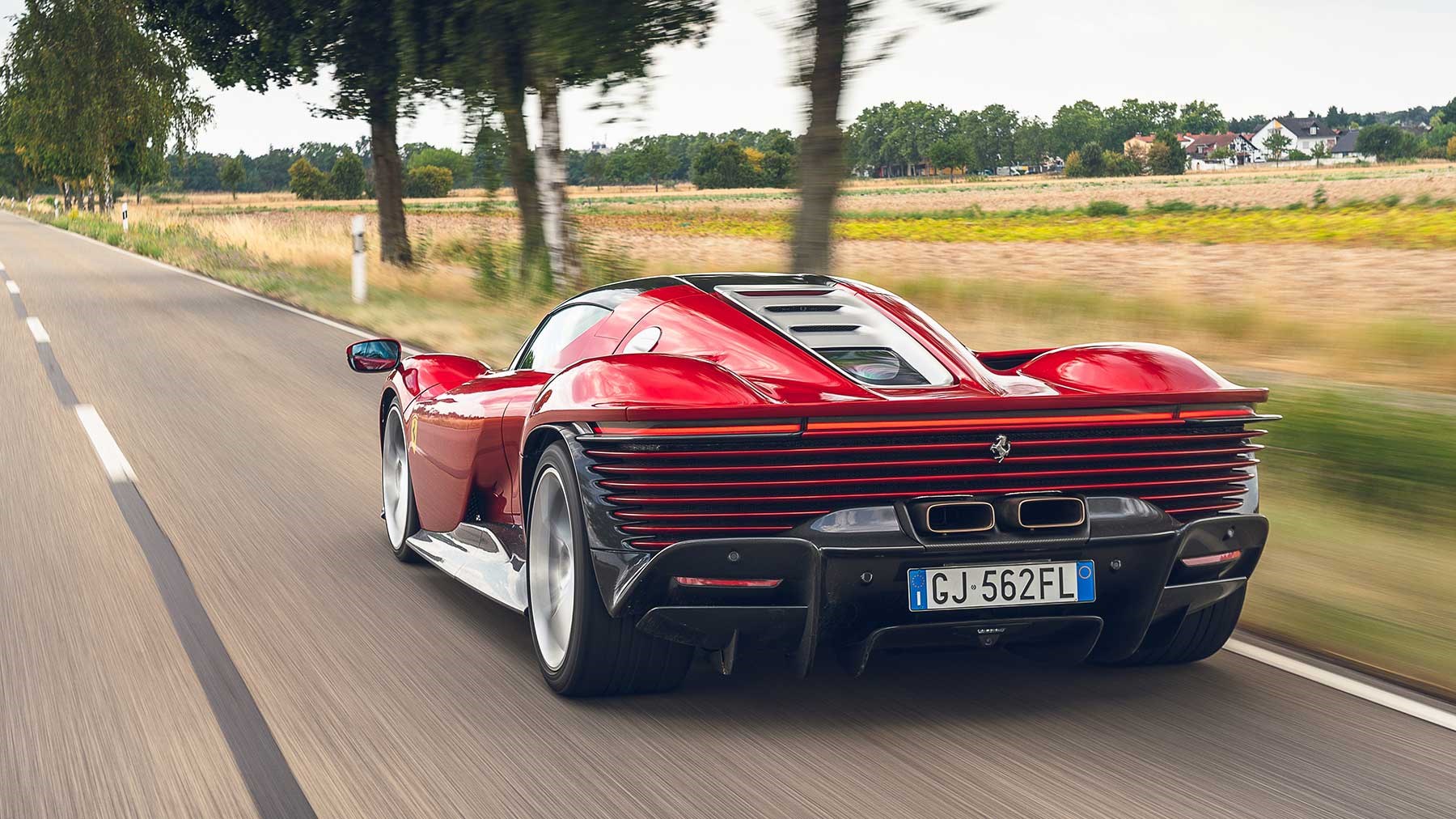
The SP3 feels resolutely planted north of 150mph. It’s claimed to be the most aerodynamically efficient ‘passive aero’ car Ferrari has ever made, i.e. one without the use of active aero devices, to keep its lines unsullied. Like other Ferraris it has relatively fast steering, which feels a little unnervingly edgy either side of the straight ahead on the autobahn but you quickly become accustomed to it.
What’s the Daytona SP3 like on twistier roads?
Soon we leave the dual carriageway behind and head for the hills, where there’s a chance for that steering to get to work properly. It’s an electro-hydraulic rack, with a decent amount of weight to it, which feels all the better for the wheel’s smaller diameter. Although still as quick-racked as you’d expect from a Ferrari, it does feel slightly more measured in its response than, for example, a 296 or an F8, and the same can be said of the brakes, which demand a little more pressure than normal in deference to the ‘classic racecar feel’ objective. It’s a car with greater communication as a result.
And 829bhp on a country road: terrifying, surely?
Not at all, incredibly; the SP3 is thoroughly tractable. The mega power output doesn’t make the engine feel peaky as I’d imagined it might. That smooth torque curve helps, as does the now-familiar manettino switch, which lengthens the leash of the intelligent traction and stability control systems with each twist from Wet through Sport and Race to CT-off (which allows controlled power slides, within reason, thanks to clever programs with names like Side Slip Control 6.1 and Dynamic Enhancer) to ESC-off. Like other modern Ferraris, the SP3 has an electronically controlled ‘e-diff’ and a host of algorithms to juggle diff, brake vectoring, electronic dampers and powertrain control software to keep €2m of Special Project Ferrari out of the scenery on a tricky road, or balletically sideways on a racetrack, depending on its owner’s desire.
One of the most appealing things about the SP3, however, is that it feels intrinsically mechanical rather than digital. The seats integrated within the carbon structure mean you feel the powertrain’s vibrations and the car’s balance through the chassis itself. Ferrari’s head development test driver Raffaele de Simone says the engine’s integration has been tuned to give it a sound and feel more in line with that of the 330 P4 and company’s era:
‘We wanted to focus more on the types of sound of the cars of that period; more mechanical, where moving parts generated the sound. The true mechanics of the valves, the valvetrain, and the intake sound.’ Engineer Gabriele Pritoni tells CAR that the dual-clutch paddleshift gearbox has been given a deliberately more abrupt, emphatic feel when upshifting manually at more than 40 per cent throttle in Race mode, to echo the feel of a classic racecar’s crash-gearbox. It’s a fractionally slower shift than it could be optimised for – but that isn’t the point, it’s about feel.
Could the SP3 have had a manual gearbox?
It simply wouldn’t have been practical. To give the powertrain the performance it needs, the milliseconds-connection between the DCT gearbox and engine management system allows active spark advancing and ‘very aggressive’ profiles for the variable valve timing to create that dizzying redline and delirious acceleration.
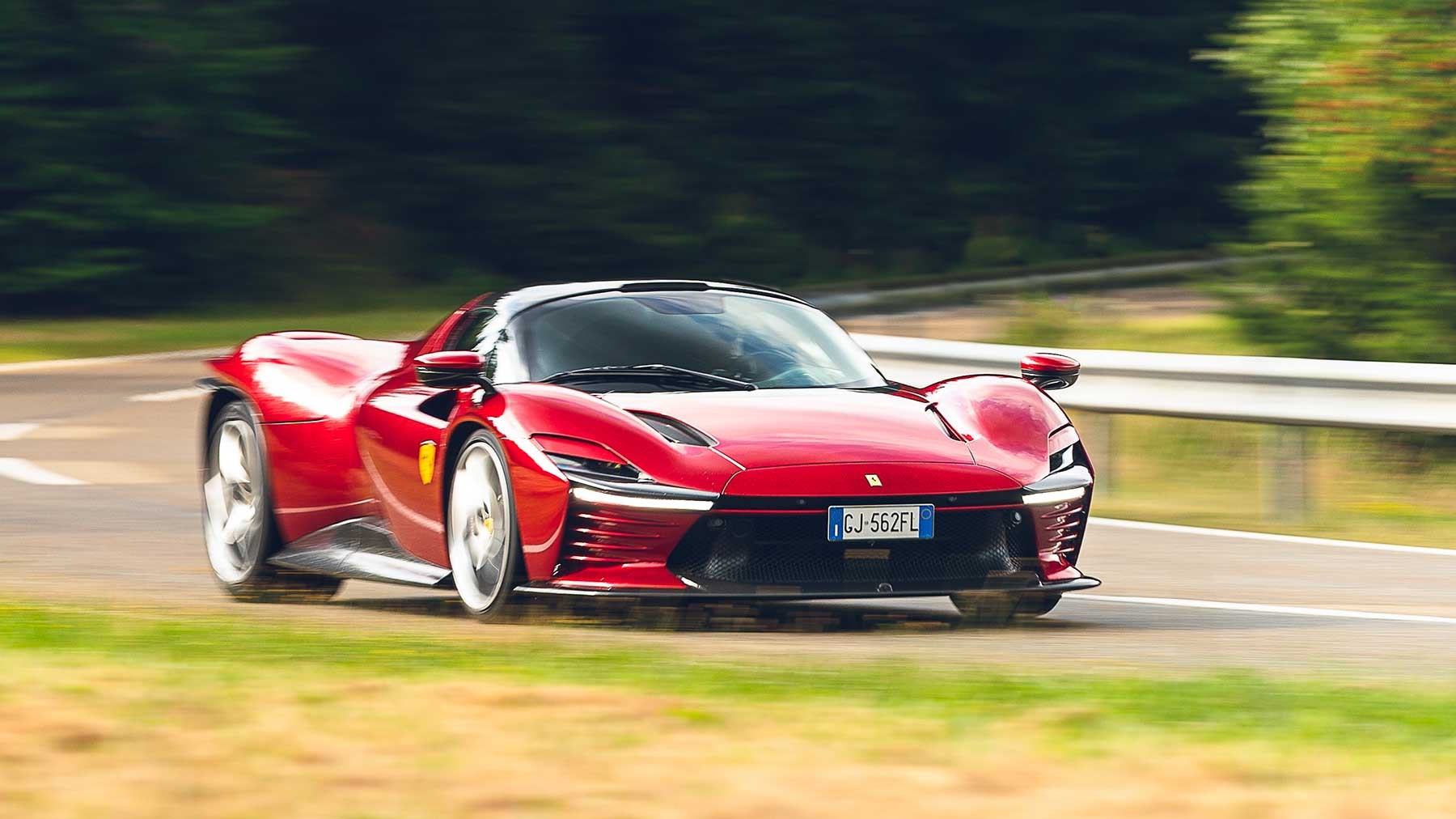
That said, although a bespoke Pirelli P Zero Corsa tyre has been developed for the SP3 and its mechanical and aerodynamic grip levels are absolutely in-line with what you’d expect of a cutting-edge supercar, dynamically Ferrari’s engineers deliberately stopped short of outright performance for the sake of performance. Raffaele de Simone continues: ‘I like the imperfections of the old racing cars and I want this to be similar in feel. I can’t make a car that’s as difficult to drive as those – hot, noisy, no ventilation – but I want to give it some of the same feeling,’ he tells CAR. ‘I want it to be a drivers’ car, for the driver to do more. I want to slow down the processes – more time to think, more time to feel the car.’
From your cab-forward vantage point, you’re very aware that there’s a lot of car behind you in the SP3, and a lot of weight to manage too with that V12. As you get on the power in a corner, you feel the car sit back on its haunches and the nose bobs on its suspension. (That sensation is accentuated or reduced depending on the adaptive dampers’ mode, which includes a silky-smooth Bumpy Road mode.)
Although even in CT-off mode you sense digital angels subtly intervening to keep you safe, you do also have the sense at all times that you’re driving the car; you’re more than a passenger along for the ride.
There’s one scenario in which the process could be perhaps slowed down even further. Through this section of the Black Forest, the road is wide and carves its way through a series of left-right meandering S-bends. Tackling roads like this in some supercars – a McLaren 600LT or 720S for example – there’s a sensation of pouring the car from corner to corner, smoothly blending from brake to throttle and back again, managing the weight transferring to and from the car’s nose as you turn the wheel. It’s more difficult to get into a rhythm in the SP3, as the brakes have an abrupt bite as you blend on – and crucially, off – the pedal, making it harder to feel at one with the car.
Still, this is after a pocketful of miles and really, we’re only just getting to know the SP3’ properly.
And a convertible too?
There’s a removable carbonfibre roof panel, the better to feel the air around you and hear the V12 at work.
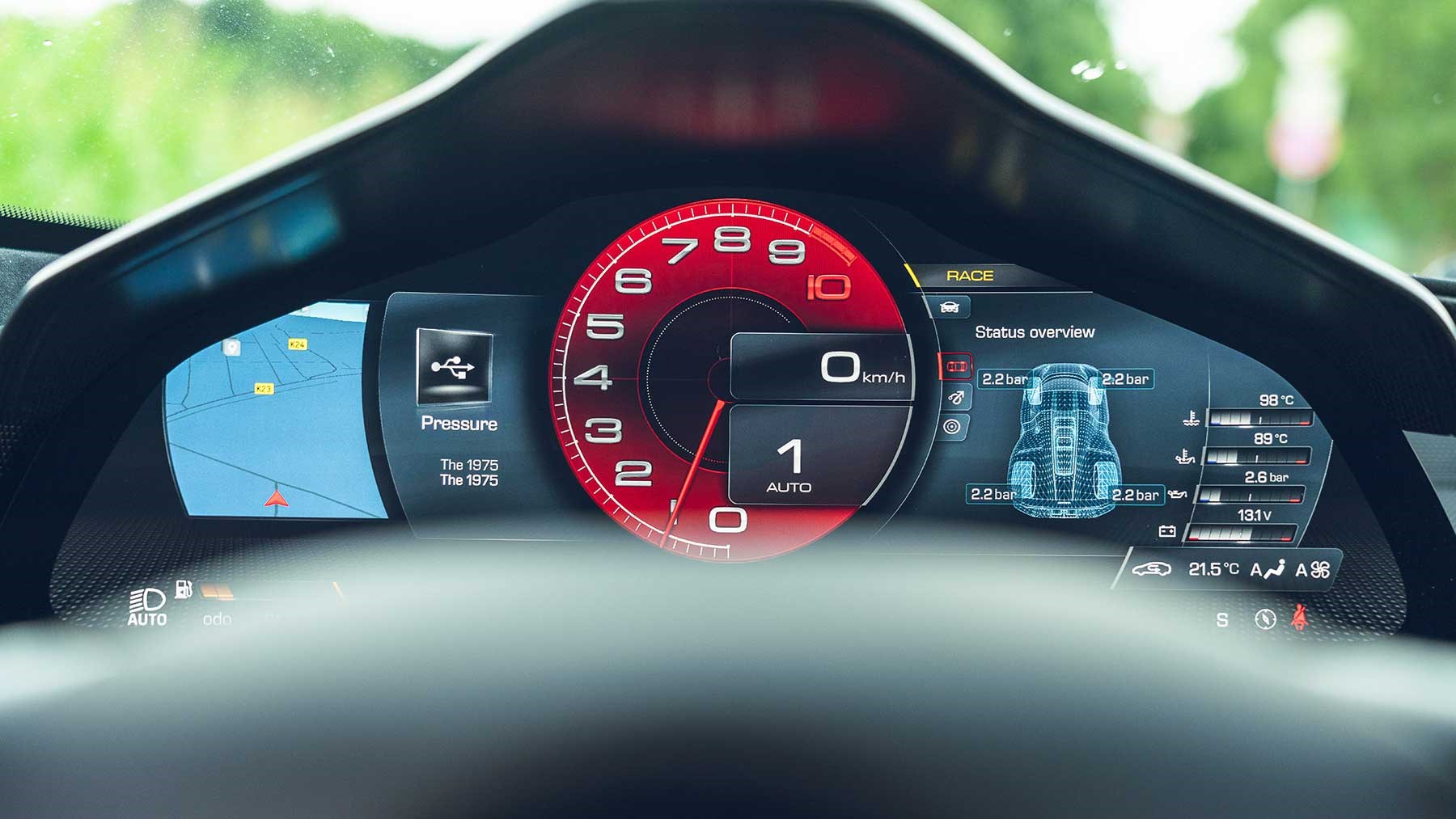
Not that there’s anywhere to put it. There’s no luggage space in the SP3; the nose compartment is taken up by an emergency fabric roof cover, in case you’re caught in rain unexpectedly. Otherwise you’ll need to leave the targa panel at home, or put it in a friend’s car. Likewise your bags.
Does the Ferrari Daytona SP3 really feel worth €2m?
The price quickly begins to add up. Take the rear deck alone, an enormous one-piece carbonfibre moulding. Creating it in big numbers for a high-volume production car simply wouldn’t be possible. Lift it upwards and it reveals gigantic, all-carbonfibre intake plenums and a shadowy glimpse of evocative red-crackle cam covers below. The engine’s prodigious power output is despite tight modern emissions and drive-by noise regulations, and the need for latest-generation catalyst and particulate filters. And those lines and proportions are concept-car spectacular despite being subject to the same pedestrian impact regulations as a regular production car.
The fact that it has stop-the-world styling, an unhybridised naturally aspirated V12 and hydraulic power steering makes it feel all the more special. Ferrari’s official line is that the Icona series is ‘a bridge of past, present and future,’ and the way this car pushes the boundaries of aerodynamic and powertrain engineering without forfeiting style and driver enjoyment makes that claim credible.
Verdict
It’s not as agile as a Ferrari F8 or a 296 but that’s not the point. It’s all about celebrating driving enjoyment, design and engineering, from a company that operates in the highest spheres of all three. Which makes the Daytona SP3 one of the ultimate expressions of what a traditional supercar can be. Whether on a grey stretch of anonymous motorway or on a dream driving road, it’s a master storyteller.
More Ferrari reviews by CAR magazine